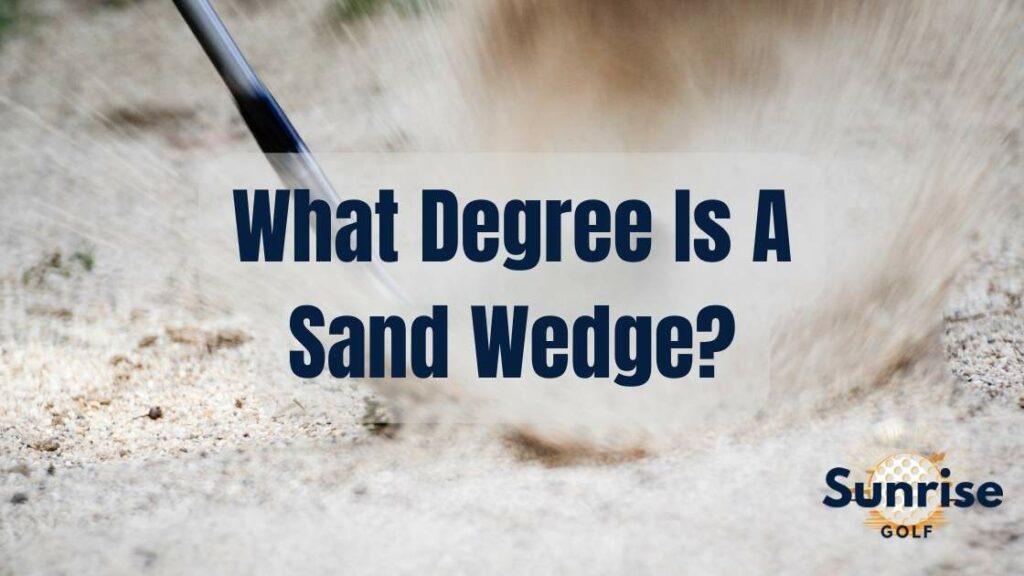Ever found yourself staring down a menacing sand trap, your heart pounding as you ponder the perfect escape shot? If you've been in this high-stakes moment, you know that choosing the right sand wedge can make or break your game. But do you know what degree your sand wedge should be?
Don't sweat it; you're not alone. In this comprehensive guide, we'll demystify the world of sand wedges for you. We'll delve into the nitty-gritty of degrees, loft, and bounce options that can turn you from a duffer into a master of the sand trap.
So buckle up! You're about to gain the knowledge and confidence to tackle any sand trap that dares to challenge you.
Understanding the Loft of a Sand Wedge
A sand wedge typically has a loft angle between 54 and 58 degrees, allowing for a high, soft shot that can stop quickly on the green.
This loft angle creates a steep descent angle, allowing the ball to come down softly and minimize the roll.
The loft of the sand wedge also helps in getting the ball out of bunkers by adding extra height to the shot.
Exploring the Clubhead Design of a Sand Wedge
With its unique clubhead design, a sand wedge allows you to make precise shots around the green.
Here's how it works:
- The clubhead of a sand wedge is designed to provide maximum versatility and control in tricky situations, such as when you find yourself in a bunker or facing a tight lie.
- The clubhead typically features a wide sole, which helps to prevent the club from digging too deeply into the sand or turf, allowing for a clean strike.
- This design also promotes a higher launch angle, which helps the ball to get up quickly and land softly on the green.
- The loft of a sand wedge can vary, but it is typically around 54-58 degrees, providing the optimal loft for shots that require a high trajectory and plenty of spin.
So, whether you need to hit a delicate flop shot or escape from a greenside bunker, the clubhead design of a sand wedge gives you the freedom to execute these shots with precision and confidence.
The Role of Bounce in a Sand Wedge
The amount of bounce on a sand wedge can vary, typically ranging from 4 to 14 degrees.
The specific amount of bounce you need depends on the type of sand and grass conditions you commonly encounter on the course.
By choosing the right amount of bounce for your sand wedge, you can have more control over your shots and feel more confident in your ability to escape bunkers and navigate tricky lies.
| Bounce (degrees) | Ideal Conditions | Suitable Conditions | Unsuitable Conditions |
|---|---|---|---|
| 4-6 | Firm, tight lies | Firm fairways | Soft, fluffy lies |
| 8-10 | Most conditions | Most conditions | None |
| 12-14 | Soft, fluffy lies | Soft, fluffy lies | Firm, tight lies |
Introducing Our Interactive Golf Slider: Find Your Perfect Launch Angle!
Are you curious about how different loft angles and angles of attack can affect your golf ball's trajectory? Our interactive slider is here to help! This easy-to-use tool calculates your expected launch angle based on the dynamic loft and angle of attack of your golf club.
Interactive Golf Slider
10 degrees1 degrees
How to Use the Slider:
- Dynamic Loft: Use the first slider to select the dynamic loft of your golf club. This is the angle of the clubface at the moment of impact and is a major factor in determining your ball's launch angle.
- Angle of Attack: The second slider allows you to choose the angle of attack, which is the angle at which the clubhead approaches the ball. This also influences the trajectory of your shot.
As you adjust the sliders, the tool will automatically calculate and display your expected launch angle. This can give you valuable insights into how different settings can affect your game.
Give it a try and find your perfect launch angle today!
How Loft Affects the Distance and Trajectory of a Sand Wedge Shot
Loft determines the distance and trajectory of a shot with a sand wedge.
The loft angle on a sand wedge typically ranges from 54 to 58 degrees, providing a higher trajectory compared to other wedges.
Here's how loft affects your shot:
- Increased loft angle increases the launch angle of the ball, allowing it to climb higher into the air. This higher launch angle helps the ball land more softly on the green, reducing the chances of it rolling too far. The higher trajectory also helps the ball clear hazards like bunkers or rough.
- Decreased loft angle decreases the launch angle, resulting in a lower, more piercing ball flight. This lower trajectory is ideal for shots where you need to keep the ball under the wind or when you want to generate more roll on the fairway.
Understanding the role of loft in your sand wedge helps you have more control over your distance and trajectory, giving you the freedom to execute the shot that best suits the situation.
Choosing the Right Loft for Your Sand Wedge
Finding the right loft for your sand wedge is essential for controlling the distance and trajectory of your shots. The loft refers to the angle of the clubface, which directly impacts how high and far the ball will travel.
When it comes to sand wedges, the standard loft is around 56 degrees. However, there are variations available, ranging from 52 to 60 degrees, to suit different playing styles and course conditions.
A higher lofted sand wedge will launch the ball higher and with more spin, making it ideal for shots that require a steep descent and stopping power. On the other hand, a lower lofted sand wedge will produce a lower ball flight with less spin, making it suitable for shots that require distance and rollout.
Certainly! You can insert the following section right after your "Conclusion" section to provide readers with some practical recommendations based on the information you've covered.
Recommended Sand Wedges Based on Loft and Bounce
Now that you're well-versed in the intricacies of sand wedge degrees, it's time to consider some top-notch options that align with the principles we've discussed. Here are five sand wedges that come highly recommended:
1. Titleist Vokey SM8 (58-degree loft, 12-degree bounce)
The Titleist Vokey SM8 Jet Black D Grind 58 Lob Wedge features a 58-degree loft, making it an excellent choice for players who often need to make high-arching shots. The D Grind provides added versatility, and the jet black finish adds a touch of style. This new wedge is perfect for those who want both performance and aesthetics in their golf gear.
2. Callaway Mack Daddy 5 JAWS (58-degree loft, 12-degree bounce)
If you're looking for a wedge that offers a high trajectory, the Callaway Mack Daddy 5 JAWS is your go-to. Its 58-degree loft and 12-degree bounce are perfect for soft, fluffy lies.
3. Cleveland RTX-4 (60-degree loft, Mid Bounce)
The Cleveland RTX-4 comes with a 60-degree loft and a mid-level bounce. This configuration is ideal for players who require a high trajectory and maximum stopping power on the green. The mid-level bounce offers a balanced performance, making it versatile enough for various course conditions.
4. TaylorMade MG2 (56-degree loft, 14-degree bounce)
For those who often find themselves in soft, fluffy lies or bunkers, the TaylorMade MG2 is ideal. It offers a 56-degree loft and a high 14-degree bounce.
5. Cobra King MIM (56-degree loft, 10-degree bounce)
The Cobra King MIM offers a 56-degree loft and a 10-degree bounce, making it a versatile choice for a wide range of conditions. The MIM (Metal Injection Molded) technology provides superior feel and precision, ideal for players looking for both versatility and performance.
Conclusion
So there you have it, now you know all about the degree of loft in a sand wedge. It plays a crucial role in determining the trajectory and distance of your shots.
Interestingly, did you know that the average loft of a sand wedge is around 56 degrees? This statistic highlights the importance of choosing the right loft for your sand wedge to ensure optimal performance on the golf course.
With this knowledge, you'll be able to make informed decisions when selecting your sand wedge and improve your game.







I use a 60° ball front of open stance gets the ball out every time
Hey Robert, that’s a solid tip with the 60° wedge and open stance!
Do you find that this works well in all types of sand, or is it a go-to for specific conditions?
Always good to hear what’s working for other golfers out there. Thanks for chiming in!
Cheers,
Linda
Please share how to maintain and control swing tempo with driver.
Hey Dennis,
Thanks for dropping by my blog and leaving a comment, I appreciate the engagement!
You asked about maintaining and controlling swing tempo with a driver, which is a great question. Swing tempo is crucial, especially when you’re wielding the big stick. Here’s my take:
Rhythm is Key: Think of your swing as a dance. It’s all about rhythm. A good way to maintain this is by counting in your head. Some people use a 3-count method: one for the takeaway, two at the top, and three on the downswing.
Practice with a Metronome: This might sound a bit out there, but practicing your swing to the beat of a metronome can really help you nail down a consistent tempo.
Breathing: Don’t underestimate the power of good breathing techniques. A deep breath before you swing can do wonders for your focus and tempo.
Don’t Rush the Top: A lot of people rush the transition at the top of the swing, which can throw off the whole shot. Make sure you give yourself a moment at the top to set up for a powerful and controlled downswing.
Hope this helps, Dennis! Let me know if you have any more questions.
Best,
Linda
This is a mind opening and educational golf analysis that can elevate your game. Thank you
Thank YOU hector, your comment made my day! 🙂
Linda
Helpful info on sand wedges…..so loft aside what brand would you recommend n does shaft make a difference??
Hi J,
Great questions! Brand preference can be subjective, but if I had to recommend one, I’d say Titleist’s Vokey series is a solid choice for sand wedges. They offer excellent control and versatility.
As for the shaft, yes, it does make a difference. A steel shaft is generally more durable and offers better control, while a graphite shaft is lighter and can help increase swing speed. Your choice would depend on what you’re comfortable with and what fits your game best.
Hope this helps!
Best,
Linda
Excellent analysis.
Thank you, Dr Nwokolo!
Linda
What happens if you hit another ball one the green? Putting or hitting from the fairway to the green?
Hi Keith,
If you happen to hit another ball on the green, whether you’re putting or approaching from the fairway, it’s considered a breach of golf etiquette. In such a situation, it’s best to promptly apologize to the other golfers on the green for any disruption caused.
Typically, the golfer whose shot was interrupted has the option to replay their shot without incurring a penalty. It’s all about maintaining a considerate and respectful atmosphere on the golf course, ensuring that everyone can enjoy their round.
Hope this helps!
Linda